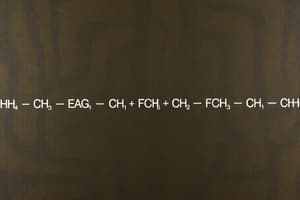Podcast
Questions and Answers
What is the primary role of cerium(IV) ions or manganese(II) ions in the Belousov-Zhabotinsky reaction?
What is the primary role of cerium(IV) ions or manganese(II) ions in the Belousov-Zhabotinsky reaction?
- To act as fuel in the reaction
- To act as indicators of the reaction's completion
- To act as oxidizer in the reaction
- To act as catalysts in the reaction (correct)
What is a characteristic of the Belousov-Zhabotinsky reaction that implies the existence of multiple stable states?
What is a characteristic of the Belousov-Zhabotinsky reaction that implies the existence of multiple stable states?
- Oscillations
- Autocatalysis
- Chaos
- Bistability (correct)
Which of the following is NOT a application of the Belousov-Zhabotinsky reaction?
Which of the following is NOT a application of the Belousov-Zhabotinsky reaction?
- Biological systems
- Modeling complex systems
- Electrochemical reactions (correct)
- Pattern formation
What is the oxidizer in the Belousov-Zhabotinsky reaction?
What is the oxidizer in the Belousov-Zhabotinsky reaction?
What is the fuel in the Belousov-Zhabotinsky reaction?
What is the fuel in the Belousov-Zhabotinsky reaction?
What type of behavior is exhibited by the Belousov-Zhabotinsky reaction when small changes in initial conditions lead to drastically different outcomes?
What type of behavior is exhibited by the Belousov-Zhabotinsky reaction when small changes in initial conditions lead to drastically different outcomes?
Flashcards
Belousov-Zhabotinsky (BZ) Reaction
Belousov-Zhabotinsky (BZ) Reaction
A chemical reaction that exhibits periodic oscillations in the concentrations of reactants and products.
Malonic Acid
Malonic Acid
The fuel in the BZ reaction, it is oxidized by bromate ions.
Bromate Ions
Bromate Ions
The oxidizer in the BZ reaction, it reacts with malonic acid.
Catalyst
Catalyst
Signup and view all the flashcards
Bistability
Bistability
Signup and view all the flashcards
Chaos
Chaos
Signup and view all the flashcards
Study Notes
Overview
The Belousov-Zhabotinsky (BZ) reaction is a nonlinear chemical oscillator that exhibits complex and dynamic behavior.
Chemical Reaction
The BZ reaction involves the oxidation of malonic acid by bromate ions in a sulfuric acid solution:
- Malonic acid (CH₂(COOH)₂) is the fuel
- Bromate ions (BrO₃-) are the oxidizer
- Cerium(IV) ions (Ce⁴⁺) or manganese(II) ions (Mn²⁺) are used as catalysts
Reaction Mechanism
The BZ reaction involves a series of complex steps, including:
- Oxidation of malonic acid by bromate ions
- Reduction of bromate ions by malonic acid radicals
- Autocatalytic steps involving the cerium or manganese ions
Characteristics
- Oscillations: The BZ reaction exhibits periodic oscillations in the concentration of the reactants and products.
- Bistability: The reaction can exhibit bistability, where two stable states coexist under certain conditions.
- Chaos: The reaction can exhibit chaotic behavior, where small changes in initial conditions lead to drastically different outcomes.
Applications
- Modeling complex systems: The BZ reaction is used as a model system to study complex and nonlinear phenomena in chemistry, biology, and physics.
- Pattern formation: The BZ reaction is used to study pattern formation and self-organization in chemical systems.
- Biological systems: The BZ reaction is used to model oscillations and nonlinear behavior in biological systems, such as chemical signaling pathways and population dynamics.
Belousov-Zhabotinsky (BZ) Reaction
Chemical Components
- Malonic acid (CH₂(COOH)₂) is the fuel in the BZ reaction
- Bromate ions (BrO₃-) act as the oxidizer
- Cerium(IV) ions (Ce⁴⁺) or manganese(II) ions (Mn²⁺) serve as catalysts
Reaction Mechanism
- The BZ reaction involves the oxidation of malonic acid by bromate ions
- Bromate ions are reduced by malonic acid radicals
- Autocatalytic steps occur involving cerium or manganese ions
Characteristics of the BZ Reaction
- Exhibits periodic oscillations in reactant and product concentrations
- Displays bistability, where two stable states coexist under certain conditions
- Can exhibit chaotic behavior, where small initial condition changes lead to drastically different outcomes
Applications of the BZ Reaction
- Used to model complex systems and study nonlinear phenomena in chemistry, biology, and physics
- Used to study pattern formation and self-organization in chemical systems
- Models oscillations and nonlinear behavior in biological systems, such as chemical signaling pathways and population dynamics
Studying That Suits You
Use AI to generate personalized quizzes and flashcards to suit your learning preferences.




